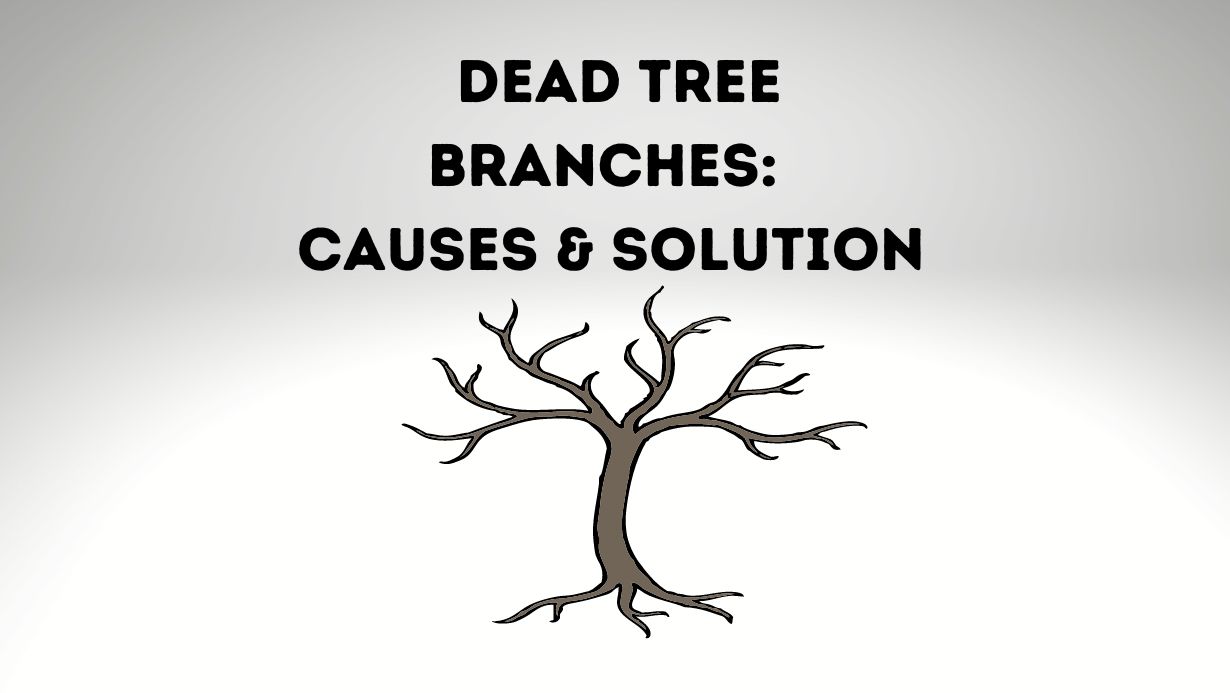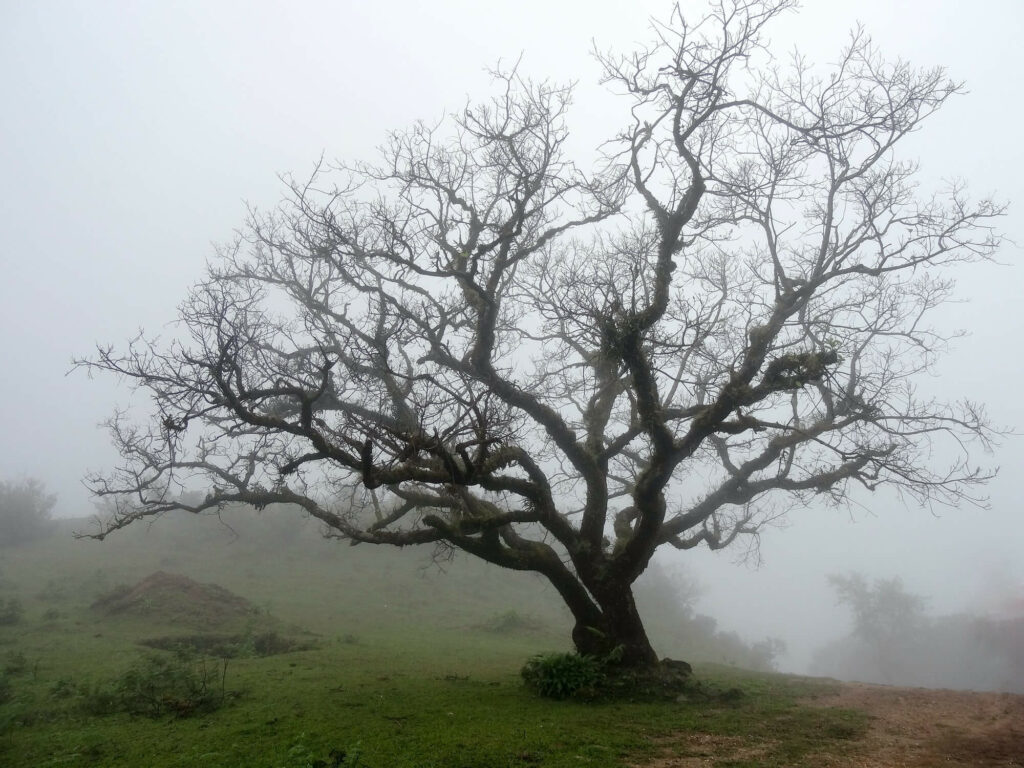
Dead branches on a tree can be unsightly and a pain to remove. But what causes them? And why only one or two limbs on an otherwise perfectly healthy tree? Let’s take a look.
In my research, I came across five common causes of deadwood. I looked further into each factor to understand the reason for deadwood, signs to look out for, and how to deal with these problems.
Main Causes of Deadwood in a Tree

1. Aging Tree
Branches dying on a tree are a natural part of a tree’s growth, and if your tree looks otherwise healthy, it really shouldn’t be an issue.
The bigger a tree gets, the more intricate the branch structure becomes. Branches cross, cover, and even grow directly into each other, sometimes causing them to compete for light. Plants need light for energy (and therefore growth) through photosynthesis.
For a quick overview of photosynthesis, a plant or tree uses sunlight to make its food. The green pigment absorbs energy from the sunlight; then, the energy helps turn water and carbon dioxide into sugar and oxygen.
The plant will either use or store the energy and send the oxygen into the atmosphere.
When larger branches cover smaller branches within the tree, the smaller branches cannot get the sunlight they need to survive; this causes the limbs to begin dying.
There are four main factors that affect photosynthesis. Check them all out here.
If nothing changes, the rest of the tree will start to seal the dying limb off from the rest of the tree. This process causes the rest of the tree to take the nutrients intended for that branch, accelerating that branch’s death; this is when you will see the deadwood.
When this happens over and over, you will start to notice deadwood throughout your tree.
You only need to prune deadwood that looks dangerous (large and weak limbs that have the potential to fall on someone). Visually you can prune your tree to your desire; know that pruning deadwood in this instance does not affect the tree’s health.
2. Sooty Mold
Sooty Mold is a broad term used to describe various fungi that grow on the sugary liquid excreted by common tree pests. These pests are usually aphids or whiteflies. Aphids and Whiteflies transmit the fungi to leaves as they feed on them.
Once infected, Sooty Mold can spread throughout the tree leaves, covering them in a black mold. As mentioned above, leaves need sunlight to survive. Suppose enough leaves get covered in a substantial amount of this mould. In that case, the branches will eventually die off, creating deadwood throughout your tree.
The most obvious sign your tree has been infected with Sooty Mold is the leaves’ black coating. The layer is dry and can potentially cover the entire leaf.
Another sign your tree has Sooty Mold is the presence of aphids or whiteflies. If you notice these few things, you can be confident your tree has Sooty Mold.
Other plants and trees in your yard could also have these symptoms, and if this is the case, it’s safe to say you also have a pest problem. They are spreading the fungi throughout your garden as they feed on each plant.
The easiest way to deal with Sooty Mold is to deal with your pest problem. One way to do this is to employ natural predators; these could be ladybugs or birds.
However, a much easier way is to spray your tree with organic sprays (soap and water or essential oils).
Once the pests have been removed, the mold should eventually wither away or be replaced with new growth. If you do not want to wait for the mold to leave naturally, soaking the leaves in dishwashing liquid can help remove it.
3. Animal Damage
There is a broad range of animals and birds that damage trees. If your tree is generally healthy, the damage caused by animals is usually not detrimental to the tree’s health. Still, there are extreme cases where trees can die if the damage is severe enough.
Some common causes of this damage are squirrels feeding on tree roots and birds destroying bark as they try to eat insects hiding in the bark crevices. Some of the early warning signs of these infestations can be deadwood.
Young trees are especially susceptible to root damage caused by Squirrels. If the roots are too severely damaged, they will begin to die off, creating deadwood within the tree. However, if too many roots die, the tree will no longer take in water and nutrients, killing the entire tree.
To learn more about tree roots, check out this extensive article.
Bird damage, if left untreated, can also potentially cause a tree to die. This happens when too much of the bark is taken off. If a tree is ringbarked (a strip of bark removed around the entire circumference of either the trunk or branch of a tree), the tree will no longer be able to send nutrients.
Eventually, that branch (if only the branch has been stripped) will starve and die. Even if the tree is not completely ringbarked, a tree with a big enough wound may struggle to heal completely, leaving the wound open to insects and disease.
Now what to do about it?
The easiest way to tell if a squirrel is eating your roots is by merely looking at any exposed roots. You will be able to see chew marks, and the layer of bark will look damaged.
Assessing for bird damage can be a little more difficult due to the injury usually being high up in the canopy. So, the best way to see bird damage would be a visual inspection.
If you can get into your tree’s canopy (or use binoculars), the damage will look similar to squirrel damage. The bark will look chewed and torn apart, potentially with wood around the site dying off.
The best way to deal with animal damage is again to deal with the animal problem first. Tree cages can prevent animals from accessing your tree, and birds of prey decoys can scare away birds. If these fail, you can also consult your local pest removal company.
Once the animals are no longer attacking your tree, it’s best to wait and give your tree enough time to heal. During this time, you can continually water your tree and provide fertilizer if necessary. Any dangerous branches should be removed to prevent injury.
4. Fungal Diseases
Fungal diseases are a common cause of deadwood throughout a tree. I briefly touched on the most common fungus, Sooty Mold, but the fungal disease is such a broad term, and the list of different types of fungus is quite extensive.
Fungus acts like a parasite; it attaches to its host and absorbs nutrients. If you happen to see fungus on your tree, know that there’s more than meets the eye.
The fungus can penetrate deep into its host. Penetrating deep into branches can cause the branches to split, crack, or even fall off entirely.
The fungus can also attack the host’s leaves, impeding the process of photosynthesis. All of this can lead to deadwood throughout your tree.
A lot of the time, you can see the fungus on your tree. The fungus can look like mushrooms, and sometimes your tree looks like it has scabs. Trees with the fungus can also start to die back (dying from the outside-in), leaving dead leaves and branches throughout the canopy.
The most common way to remove fungus from a tree is to cut out the fungus itself, usually by pruning the infected limbs. But be careful not to spread the fungus when cutting.
After each cut, you should spray your tools with fungicide. Once the infected branches have been removed, spray the rest of your tree with a fungicide as well. Your tree should recover with time.
5. Water Damage
Water damage can occur from flooding and excess watering. Flooding can deprive a tree of oxygen and change the PH level in the soil.
Roots need oxygen to survive, and if the soil doesn’t drain quickly enough, the roots may start to die off. Again, if too many roots are dying, the tree itself won’t receive enough nutrients and begin to die, limb by limb.
Trees also need varying PH levels to survive and flourish. Therefore changes to the PH levels can cause stress to a tree and eventually lead to its death.
You will generally be able to see when a tree has been flooded, usually from excess watering or rainfall. However, if the flooding is not apparent from an underground leak, you might notice damp, wet soil and that the tree base is moist.
The best thing to do for flooding is to find a way to drain the soil. If drained and the tree isn’t recovering, you can do a simple PH test. Knowing your soil’s PH and the ideal PH range for your tree will enable you to rebalance the soil and give your tree a chance to heal.
